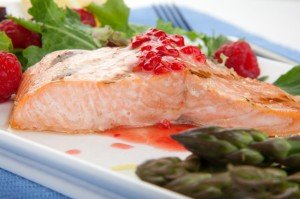Raspberries: Anthocyanin Power
Antioxidants have been all the rage over the last several years, to the point that they have become synonymous with "anti-aging" and "disease prevention." But it turns out that antioxidants don't work inside the body quite the way they do in a test tube (which is what stimulated so much research in the first place). We don't actually know if and how ingested antioxidants will be absorbed and used by the body to squelch fee radicals (potentially problematic molecules in the body), as often touted. In fact, researchers are not sure how phytonutrients work inside us, but they have learned that it's complicated and that several pathways are used, which greatly contrasts the previous over-simplified free radical scavenger explanation. But what has become clear through the massive amounts of research on antioxidants is that one particular flavonoid, anthocyanin, has an amazing impact on our health. These colorful phytonutrients, which give the bright red-orange to blue-violet color to many fruits and vegetables, are made by plants to protect them from environmental hazards such as drought, cold temperatures and ultraviolet light.
Raspberries and Disease Prevention
Anthocyanins are powerful compounds that seem to reduce risk of chronic diseases like type 2 diabetes, heart disease, and cancer, as well as brain function in regards to memory and age-related mental decline. Type 2 diabetes typically occurs because insulin becoming less effective at keeping blood sugars at normal levels. Anthocyanins appear to help maintain normal blood sugars using less insulin. Several studies have found that foods high in anthocyanins protect against heart disease. Anthocyanin-rich foods are consistently shown to be associated with decreased death from cardiovascular disease, decreased risk of developing high blood pressure, and fewer heart attacks in large human studies. Other human studies lasting a few weeks found that eating berries daily reduced problematic LDL (bad cholesterol) by about 30%.It's important to eat a variety of colorful fruits and vegetables every day to consume a wide range of important nutrients, but given the power of anthocyanins, try to include one red/blue colored fruit or vegetable high in these powerful anthocyanins every day, or at a minimum, 3 times per week.
Raspberries also offer other excellent benefits. They are an excellent source of vitamin C, manganese, and dietary fiber. One cup of raspberries contains 43% of our daily recommended value of vitamin C, 41% DV of manganese and 32% DV of fiber (8g fiber). They are a good source of copper, vitamin K, pantothenic acid, biotin, vitamin E, magnesium, folate, omega-3 fatty acids, and potassium, as well as many beneficial phytonutrients. One phytonutrient in particular is worth noting: the ellagitannin in raspberries may be able to help eliminate some cancer cells. In potentially cancerous cells, phytonutrients in raspberries may be able to trigger signals that encourage the non-cancerous cells to remain non-cancerous.
Take advantage of the delicious fresh raspberries in season now, but don't hesitate to use frozen raspberries all year long, as they are frozen within just hours of being picked. Take July's Healthy Challenge and eat lots of nutrient-rich raspberries to improve your health!


